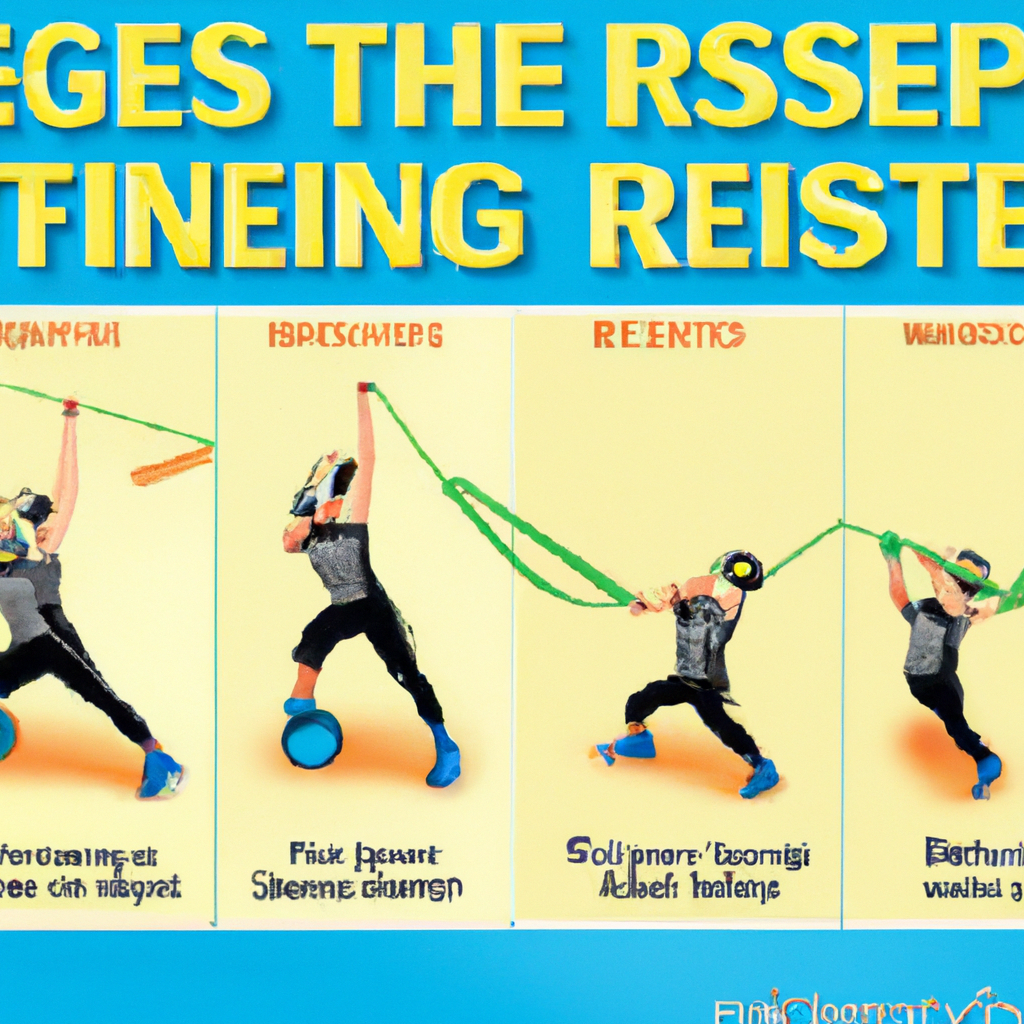Looking to add some variety to your bicep workout routine? Resistance bands may be just what you need. But before you grab those bands and start curling away, it’s important to know the best technique to get the most out of your workout. In this article, we’ll explore the recommended technique for using resistance bands for bicep curls, ensuring you get the maximum benefit from this effective exercise. So, let’s dive right in and discover how to make those resistance band bicep curls count!
Overview
What are resistance bands?
Resistance bands are a versatile and effective piece of exercise equipment that provide resistance when stretched. They are made from strong, flexible materials such as latex or rubber and come in various lengths and tensions. Resistance bands are commonly used in strength training and are effective for targeting specific muscle groups, including the biceps.
Why use resistance bands for bicep curls?
Resistance bands offer several advantages for performing bicep curls. First, they provide a variable resistance throughout the range of motion, challenging and engaging the biceps muscles more effectively than traditional weights. Second, resistance bands are portable and lightweight, making them an ideal choice for home workouts or when traveling. Lastly, they offer a safer alternative to heavy weights, reducing the risk of injury while still delivering impressive results.
Choosing the Right Resistance Bands
Consider your fitness level
When choosing resistance bands for bicep curls, it’s essential to consider your fitness level. Resistance bands are available in different tensions, typically classified by color-coded bands. Beginners or individuals with less upper body strength may want to start with lighter resistance bands, while more advanced users can opt for bands with higher tension.
Determine the appropriate resistance
To determine the appropriate resistance for bicep curls, consider the number of repetitions you can comfortably perform. If you can complete 8-12 repetitions with good form, the resistance is likely appropriate. If you can easily exceed 12 repetitions, consider using a band with higher tension. Conversely, if you struggle to complete 8 repetitions, it may be beneficial to use a band with less tension.
Check for durability and quality
When selecting resistance bands, it’s essential to check for durability and quality. Look for bands that are made from high-quality materials, such as latex or rubber, to ensure they can withstand regular use without breaking or losing their elasticity. Additionally, inspect the bands for any signs of wear or damage before each use to prevent accidents or injuries.

Proper Set-Up
Secure the band
Before starting your bicep curls, it’s vital to secure the resistance band properly. Begin by stepping on the band with both feet, ensuring it is centered under the arches. If using a looped band, position one foot inside the loop and step on it. This will anchor the band and prevent it from slipping or moving during the exercise.
Position your body
Proper body positioning is crucial for effective bicep curls. Stand tall with your feet shoulder-width apart and knees slightly bent. Engage your core muscles and maintain a neutral spine throughout the exercise. Keep your shoulders relaxed and avoid shrugging or hunching.
Grip the band
To ensure a secure grip, hold the resistance band with an underhand grip using both hands. Keep your palms facing forward, and ensure there is adequate tension in the band to engage the biceps muscles during the curling motion.
Basic Technique
Start with proper form
Begin the bicep curls by fully extending your arms, keeping them straight but not locked. This starting position ensures that the biceps muscles are fully stretched before the contraction phase of the exercise. Maintain a slight bend in your elbows to avoid placing excessive stress on the joint.
Engage your biceps
To engage the biceps muscles effectively, exhale as you slowly bend your elbows and lift your hands towards your shoulders. Keep your upper arms stationary and focus on contracting the biceps throughout the movement. Pause at the top of the curl, feeling the contraction in your biceps, before slowly lowering the resistance band back to the starting position.
Control the movement
Maintaining control throughout the entire range of motion is crucial for maximizing the effectiveness of bicep curls with resistance bands. Avoid swinging or using momentum to lift the band, as this can diminish the impact on the biceps muscles. Instead, focus on a smooth and controlled movement, both during the concentric (lifting) and eccentric (lowering) phases of the exercise.

Variations
One-arm bicep curls
To add variation to your bicep curls, try performing them with one arm at a time. Secure the resistance band in the same manner as before, and instead of holding it with both hands, hold it with just one hand. This variation challenges your biceps and also improves stability and balance on each side of the body.
Hammer curls
Hammer curls target not only the biceps muscles but also the brachialis, which lies beneath the biceps. This variation is performed by gripping the resistance band with your palms facing each other, mimicking a hammer grip. Perform the curls in the same manner, with controlled movements and a focus on engaging the targeted muscles.
Preacher curls
Preacher curls are an excellent variation for isolating and targeting the biceps muscles. To perform preacher curls with a resistance band, secure one end of the band under your foot and hold the other end with an underhand grip. Position your elbow on a stable surface such as a bench or chair, keeping your arm extended. Bend your elbow and curl the resistance band towards your shoulder, focusing on contracting your biceps.
Tips for Effective Workouts
Warm up before exercising
Before beginning any exercise routine, it is essential to warm up. This helps prepare the muscles for the upcoming activity and reduces the risk of injury. Prior to bicep curls with resistance bands, perform light cardiovascular exercises such as jogging or jumping jacks to increase blood flow and warm up the body.
Maintain proper posture
Maintaining proper posture throughout your bicep curls is crucial for maximizing the benefits of the exercise. Stand tall with your shoulders back and avoid slouching or arching your back. Engage your core muscles to stabilize your body and prevent unnecessary strain on other areas.
Gradually increase resistance
To continuously challenge your biceps and promote muscle growth, gradually increase the resistance of the band over time. As your strength improves, opt for bands with higher tension or utilize multiple bands together to intensify the exercise. However, always prioritize maintaining proper form and technique to avoid injury.
Common Mistakes to Avoid
Using momentum
One common mistake when performing bicep curls with resistance bands is using momentum to lift the band. This robs the biceps muscles of proper engagement and reduces the effectiveness of the exercise. Instead, focus on a controlled and deliberate movement, ensuring that the biceps are doing the work.
Incorrect grip
Using an improper grip can also hinder the effectiveness of bicep curls. Ensure that you hold the resistance band with an underhand grip, palms facing forward. This grip helps target and engage the biceps muscles more effectively than other grips.
Not fully extending or contracting the muscle
It is crucial to fully extend your arms at the starting position of each curl to ensure that the biceps are fully stretched. Likewise, ensure that you contract the biceps fully at the top of each curl by squeezing the muscle. Not fully extending or contracting the muscle limits its range of motion and reduces the effectiveness of the exercise.
Safety Precautions
Consult with a healthcare professional
Before starting any new exercise routine or if you have any underlying health conditions, it is always advisable to consult with a healthcare professional. They can provide personalized guidance and ensure that bicep curls with resistance bands are safe and suitable for your individual needs.
Listen to your body
Listen to your body during resistance band bicep curls. If you experience any pain or discomfort, especially in the biceps or joints, stop the exercise and reassess your form or resistance level. Pushing through pain can lead to injury and hinder your progress.
Avoid overexertion
While resistance bands provide an excellent workout, it is important not to overexert yourself. Start with lighter resistance bands and gradually increase the intensity as your strength improves. Pushing your body too hard or using bands with excessive tension can strain your muscles and increase the risk of injury.
Incorporating Resistance Bands Into Your Routine
Include bicep curls in your workout plan
To incorporate resistance bands into your workout routine, consider including bicep curls as a dedicated exercise. Aim for 2-3 sets of 8-12 repetitions, ensuring that you maintain proper form and engage your biceps muscles throughout each rep. Over time, you can increase the resistance or experiment with different variations to challenge yourself further.
Combine with other resistance exercises
Resistance bands can be a versatile addition to your workout routine. Consider incorporating other resistance exercises targeting different muscle groups, such as tricep extensions or lateral raises. By diversifying your exercises, you can achieve a full-body workout and avoid reaching a plateau in your progress.
Conclusion
Resistance band bicep curls offer a convenient and effective way to target and strengthen your biceps muscles. By choosing the right resistance bands and following the proper set-up and technique, you can maximize your results and avoid common mistakes. Remember to warm up before exercising, maintain proper posture, and gradually increase resistance to continuously challenge your muscles. With the safety precautions in mind, enjoy the benefits of resistance band bicep curls and continuously improve your technique for stronger, more defined arms.
